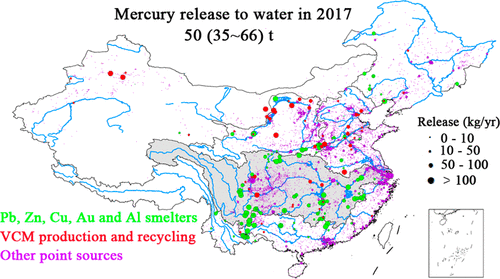当前位置:
X-MOL 学术
›
Environ. Sci. Technol.
›
论文详情
Our official English website, www.x-mol.net, welcomes your
feedback! (Note: you will need to create a separate account there.)
Highly Resolved Inventory of Mercury Release to Water from Anthropogenic Sources in China
Environmental Science & Technology ( IF 10.8 ) Pub Date : 2021-09-30 , DOI: 10.1021/acs.est.1c03759 Kaiyun Liu 1 , Qingru Wu 1, 2 , Shuxiao Wang 1, 2 , Daiwei Ouyang 1 , Zhijian Li 1 , Dian Ding 1 , Guoliang Li 1 , Yi Tang 1 , Longyi Xiang 1 , Deming Han 1 , Minneng Wen 1 , Tonghao Liu 3 , Lei Duan 1, 2 , Hezhong Tian 4 , Jiming Hao 1, 2
Environmental Science & Technology ( IF 10.8 ) Pub Date : 2021-09-30 , DOI: 10.1021/acs.est.1c03759 Kaiyun Liu 1 , Qingru Wu 1, 2 , Shuxiao Wang 1, 2 , Daiwei Ouyang 1 , Zhijian Li 1 , Dian Ding 1 , Guoliang Li 1 , Yi Tang 1 , Longyi Xiang 1 , Deming Han 1 , Minneng Wen 1 , Tonghao Liu 3 , Lei Duan 1, 2 , Hezhong Tian 4 , Jiming Hao 1, 2
Affiliation

|
This study developed an up-to-date and point-source-based inventory of mercury (Hg) releases to water in China by applying probabilistic release factors that combined industry removal efficiencies, reuse of reclaimed water, and receiving water types. In 2017, the national mercury release to water was estimated to be 50 (35–66) tons, in which 47%, 8%, 7%, and 25% were from nonferrous metal smelting, vinyl chloride monomer (VCM) production, coal-fired boilers, and domestic sewage, respectively. Approximately 95% of mercury was released to inland rivers, and the rest was discharged to lakes or coastal water. The significant sources were identified based on their mercury releases to water. The control of mercury release to water in China shall focus on zinc smelting plants, municipal sewage treatment plants, and the VCM production process. For zinc smelting plants, China can tighten the limit of mercury concentration in discharged wastewater and combine Hg-catcher device in traditional integrated treatment. For municipal sewage treatment plants and the VCM production process, promoting processes of Hg-free production can reduce mercury inputs at the source. Our study provides insights for other parties to identify the relevant sources of mercury release to water and to conduct control measures, so as to promote the global convention implementation.
更新日期:2021-10-19









































 京公网安备 11010802027423号
京公网安备 11010802027423号